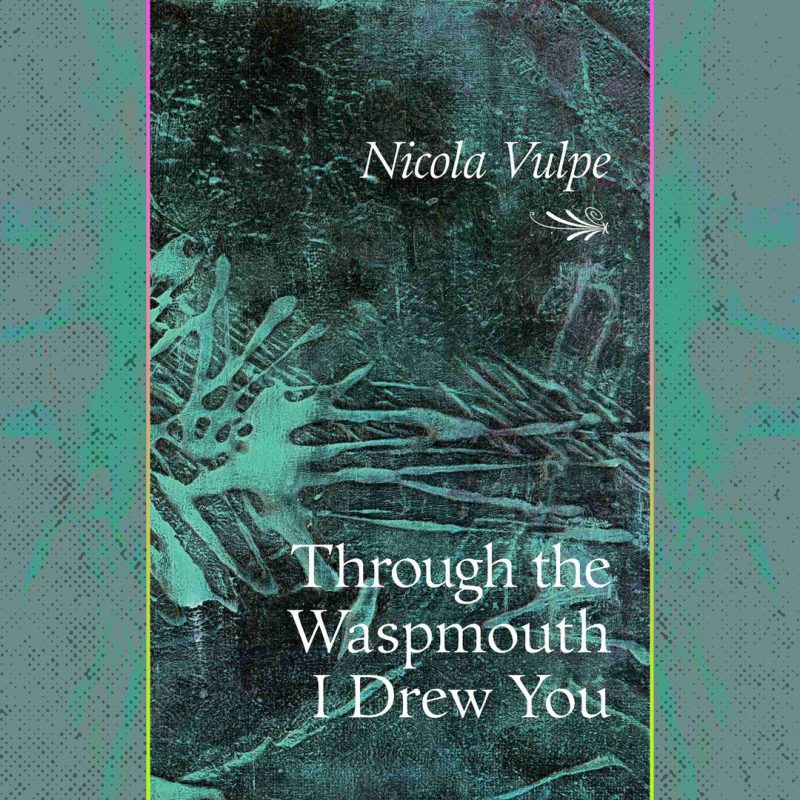USEREVIEW 083: Kenningdom
In this lush and ambitious traditional review, Elizabeth Upshur coins stunning neologisms in order to craft a review that matches the linguistic elasticity of Nicola Vulpe’s latest poetry collection Through the Waspmouth I Drew You (Guernica Editions, 2021).
ISBN 978-1-77183-591-6 | 80 pp | $20 CAD — BUY Here
#CAROUSELreviews
#USEREVIEWEDNESDAY
Spending time with a book of poems is the smallest of demands, and yet it offers the greatest of rewards if we can connect with the poet’s vision, their language and their white-hot centre that compelled the book out of nothingness into the pages in our hands. Nicola Vulpe’s Through the Waspmouth I Drew You does just that, with a mediated progression through a burgeoning and continued mythic, kenning-adjacent rich language, a dive into religious motifs and the stark, almost Gothic end contemplating the End / Death. Vulpe invites us to make meaning of a life well lived in these pages through a careful exuberance of language and words. His stylized epic pays homage to Old English poetry through kennings, poetic compounds for common nouns, with famous examples in classic literature such as Beowulf’s “whale-road” for the sea, or “battle-sweat” for blood, and the tradition is greatly enriched in this modern and buzzy take. His grammar expands through repetition and metaphorical kennings, providing a telescopic lens on its mythic subject through its Roman numeral sections culminating in an address and acceptance of Death as both concept and enigmatic character.
One of the most wonderful and poignant meta moments on the page occurs in XXXVIII:
I have adzscraped every page, razorsquiggled every line.
I have unstrung, restrung, unstrung …
every wrigglinsyllableheap.
Vulpe’s book contains a thousand near-kennings, words that are conjoined, their sensory images magnified as they crescendo through both proximity and the narrative’s arc, some becoming familiar like our guide the pinkparrot, while others are momentary descriptors like “whistlehymn … cloudmoorings.” Each turn and subversion of these conjoined words delights, tangles, connects, and celebrates the elasticity of the English language: “[t]ake this pen, write without enmity / Its breath in your ear, write what you hear it speak.” Speak is such an operative word here, building on the allusions to the epic language in the individual poems, and the language-tamed characters of Gilgamesh that are woven throughout the entire piece. By language-tamed, I refer to the way a character’s behavior changes once they are introduced to language, its soothing, humanizing and magical effect that allows for deeper connection and conversation. And of course, it is not just humans that are speaking, but wasps, blue crows and parrots.
A through line in the poems is the parrot, which stands as a linguistic mimic in American media, reverberating in cultural memory as a pirate accoutrement in dozens of films, including Jaffar’s accomplice Iago in Aladdin, the tongue-in-cheek Polly in Scary Movie II, and more recently the inseparable Blue and Jewel in Rio. The symbolism of the parrot is inextricable from mimicry, and with this at the forefront of our mind, we read lines like “the pinkparrot considers the mirror,” understanding that this book is to be read as an epic song, a song in conversation with its allusions and as a call to action for first mimicry and then our own reinterpretation of not only words, but the actions that ensue from them. In XXVIII, “Ask the parrot / a poem begins with a word / just one, my pinkcrested friend / just one will do.”
There is such a striking, almost drum-like cadence, that calls to mind creation tales of the first humans being told around a campfire. We witness the way that a name for the parrot or the wasp attempts to separate the supernatural from the natural (ordered) world, shaping and moulding this stimuli we are exposed to into a concrete part of existence, “I name, I name. I name, I name, I name / nothing from nothing from nothing … clay.” We are making a story that makes sense to us, that is, we are making three acts out of chaos. There is so much to appreciate in the origin’s opposition to the decay that spins out later on in the text.
Death is a hard thing to encounter because of how much psychic weight it has, it is something that will happen to all of us yet impossibly little is known about it, and writing about it risks a lot of sentimentality that is difficult to earn in a short amount of space and time. To put Death, or an encounter building towards Death, on the page in a way that is new, surprising, or relevant is difficult, especially now when death is so harrowing and present due to the pandemic, but we are in good hands through our journey to the Underworld. Vulpe’s penultimate poem describes Death in a way that manages to be reverent and striking. It is not some cloud or spectre, no, the “conclusion lizards into us all.” The image of the tail, of the reptilian body, the irony of its placement on the 66th page, is in conversation with so many different aspects of both neutral and malevolent serpentine myths — I’m thinking, of course, of the Viking’s World Serpent in Norse mythology, or the Egyptian Ouroboros and its continual circle of rebirth and death through the eating of its own tail. Or the snake in Gilgamesh who thwarts the hero’s quest for immortality, which keeps Gilgamesh human and relatable to the audience. Or the Bible’s serpent which introduces sin into the world through its seduction of the first humans in the Garden of Eden and the subsequent curse to crawl upon its belly for all time. There is a remnant of horror intrinsic to the image, that slithering evoked from the “lizarding” as something alien devours its way into the human heart.
This book has been an absolute highlight of my year, reinvigorating my awe of what contemporary poets and their poems are doing in the writing world. Vulpe’s language continually coaxes the reader to see anew; one is reborn as a poet by having read this book. Consider the wasp, Vulpe urges, how it chews down wood and, in the commixture of its own saliva, scaffolds, builds, erects something out of nothing. When Vulpe says that this is how his speaker draws out words, through a wasp’s mouth, it is the most intimate of relationships. The wasp may be one of the most instinctually and colloquially feared pest insects, but here we build alongside it, cohabitating in the most cunning and comforting of houses.


